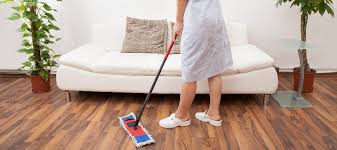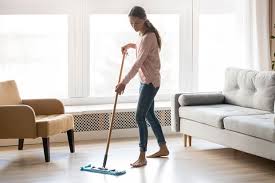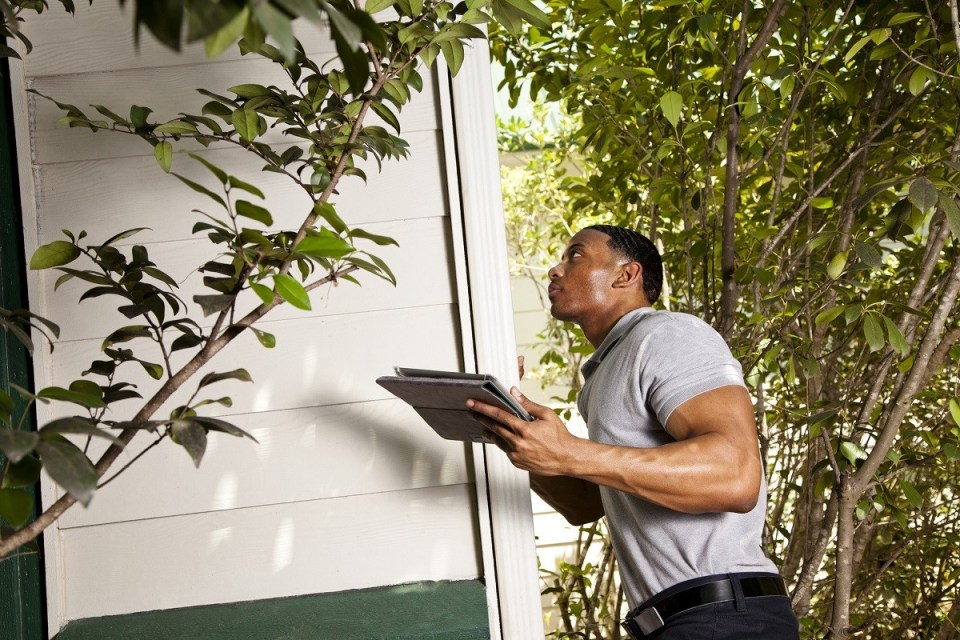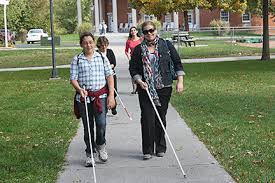How To: Clean Laminate Floors
With regular maintenance and careful cleaning, you can keep your laminate floor looking shiny and new. Laminate floors are so beautiful when first installed, but over time they can start to look a little worse for wear. Of course, unsightly streaks and blemishes need not be permanent. By following these simple guidelines, you can clean laminate floors effectively and restore their original sparkle and luster.
Basic Cleaning
If you’re going to coexist happily with this particular flooring material, then you’ve got to know one thing: Laminate hates water. If you allow the flooring to get overly wet, then the installation may warp as moisture seeps between and under the boards. That said, mopping is often the best way to clean laminate floors. So how the heck do you mop the laminate surface without putting it in jeopardy?
There are two methods:
- Use a flat mop and wring it out often; it should remain damp but never make contact with the floor when dripping wet.
- Working in sections, use a spray bottle to mist the floor, then promptly go over with a dry mop. If the floor still looks wet a minute after you’ve mopped it, that means you’re probably using too much water.
Chemical Cleaners
When plain warm water doesn’t cut it, consider using a store-bought commercial cleanser. Take care in making your product selection, however. Some chemicals in common floor cleaners can damage laminate, so it’s prudent to double-check the packaging to be certain you are purchasing something that’s laminate-safe. Also, remember that using twice the recommended amount won’t render the floor twice as clean. Rather, the excess leaves a streaky, cloudy residue that actually makes the floor look dirty.
Stain Removal
For a tough stain that neither water nor floor cleaner can budge, try an acetone-based solution, such as nail polish remover. Apply it directly to the stain, in as small a quantity as possible. Once the solution has done its work, wipe it away with a soft, clean cloth (not with a scouring pad or anything else that could leave scratches). Another good thing to know: If you’re trying to remove a hard, stuck-on substance like wax or gum, harden it first with an ice pack, then scrape it away with a plastic putty knife.
Regular Maintenance
The least demanding, most reliable way to clean laminate floors is through light but consistent maintenance. Once a week—or as often as traffic in the room demands—sweep or vacuum the floor to control dust and debris. Given the sensitivity of laminate floors to moisture, wipe up spills swiftly after they occur.
Laminate floors shown in magazines and catalogs always shine brilliantly, don’t they? Well, yours can too! Once you’ve managed to get the floor clean, follow up with a soft cloth (or an old T-shirt) and buff the surface using circular motions to achieve a gleaming polish.

How To Clean Dust From Laminate Floors
Regular cleaning of dust can keep your laminates clean. When dust accumulates on the laminate floor, people will trample on it, thus making it stick on the floor surface and mask the laminate floor shine. Therefore, we recommend regular sweeping to prevent dust build-up on the floor surface. Daily dust removal is the first method of making laminate floors shine. You can achieve that through the following steps:
- Remove dirt, dust and loose debris from the floor surface by use of vacuum or a microfiber mop.
- When using a vacuum, avoid using the hard floor attachment to prevent causing scratches on the floor. Moreover, do not use a vacuum with a beater bar.
- Avoid hard scouring brooms as they may leave scratches on your flooring too.

Protecting Your Laminate
- Place mats inside any exterior doorway over your Pergo floor to collect sand, gravel, or dirt tracked in the home. You can also place area rugs in other spaces for extra coverage.
- Make sure your rugs have a solid backing, so soil doesn’t sift through the rug to come in contact with the floor.
- Use floor protectors or felt covers on chair legs, sofas, TV stands, tables and other easily moveable furniture so you don’t scratch the floors.
- Replace plastic casters on chairs with rubber wheels.
- Lift, don’t slide, heavy objects across floors.

How to Restore Laminate Flooring
If you are a homeowner, you have a lot of pain about your new responsibilities. Of course, some of these responsibilities are universal to anyone, who wants to keep their home clean and fresh. Even apartment dwellers must clean their floors occasionally. So, let’s start from your floor! With this in mind, it is absolutely essential to learn how to clean and maintain your laminate floors properly. Do you want to know how to restore laminate flooring? The process isn’t fun, but there are a few tips, which can make it easier and more effective.
Prevent Pollution!
If you really want to know how to restore laminate flooring, prevent pollution! In order to keep your laminate floors looking great, you should first take steps to prevent them from being dirtied in the first place! Although laminate isn’t as easy to dirty up as carpet, you should still make sure that always take your shoes off, before entering your home. This simple jest will prevent tracking mud, dirt and other debris onto the laminate. You should also realize that sand and stones could get stuck in your shoes as much as your high heels. So, don’t forget to take your shoes off!
Also, you shouldn’t forget to place a rug or matt at the front door. It’s for your guests who aren’t going to be so responsible and clean their shoes. Giving them a rug will encourage them to wipe off their feet, before entering your home. Finally, you should make sure to protect your floors, by using runners or rubber stoppers on the bottom of furniture.
This will help to prevent your laminate from being scratched or damaged in any way.
Clean It!
When wiping up a spill, you should make sure to use a homemade natural cleaner. This combination will not only keep your home clean of dirt, but it’ll also prevent exposing your family and pets to harmful chemicals. Also, you should consider using a microfiber pad, NOT A BRUSH when cleaning your floors without chemicals. The microfiber cloth will be extra soft and will not damage the laminate. When forced to dry clean the floors, you will usually be able to get by with using a vacuum.
See, it is not difficult to keep your laminate floors perfectly clean, you should make sure to get into the habit of cleaning them every day! Vacuuming and sweeping is absolutely possible!
Just be careful! Using a flat cloth mop and a very mild spray cleaning solution each day is highly recommended. This will help to lift the dirt and debris from the laminate, without difficulty. Also, you might want to find and utilize the best vacuum for hardwood floor! This will give you the ability to quickly clean up food crumbs and other items, when needed.
Restore It!
Restoration needs special skills. Do you want to know how to restore laminate flooring? If you want to do it quickly you can hire a professional service or try to do it on your own. Let’s see!
In order to take the task on your own shoulders, you’ll need to equip yourself with the appropriate supplies. Although you can rush out to your local store and purchase some type of floor cleaner, you might want to consider making your own. Don’t worry, because you won’t need a lot of supplies. In fact, it is possible to throw together some water and a small amount of vinegar. This magic combination can be added to a spray bottle and can effectively clean your laminate floors.
Once you’ve finished cleaning the floor with the mop, you will want to make sure to clean the floors with a soft cloth or microfiber cloth. Make sure that you remove all of the standing water, because it could cause damage to your laminate.
Another effective chemical for restoring your laminate floors is hand soap and even baby shampoo! This might sound like a joke, but the baby shampoo can work perfectly and will make your laminate floors look bright and clean! This is one of the best pieces of advice you could ever find for proper laminate floor care! Try it!
How do I get my laminate floors to shine?
One of the best things about laminate floors is they look flawless and shiny. They can remain that way with proper maintenance. Still, residue and dirt buildup from unsuitable cleaning items may accumulate on laminate and reduce its quality.
The secret to restoring shine to your flooring is through the proper cleaner type. Also, stop using certain unfriendly products on the floor as soon as you can.
Step 1. Sweep or vacuum
First, get rid of dirt and dust from your floor using a mop. Laminate is a thin wood layer over synthetic medium density fiberboard. It is vulnerable to surface damage. That is why you should not use any abrasive cloths or mops.
You can vacuum the laminate, which is much more effective at gathering fine dust particles. Still, make sure you avoid scratching or dulling the floor finish by using the hard floor attachment. Say no to vacuums with the beater bar to prevent the buildup of grit and dirt.
Step 2. Use the right cleaner
The vinegar and water solution is the best homemade way to go for me. It is inexpensive and works sufficiently. I put a 1/2 and 1/2 combination of water and white vinegar in a spray bottle.
If you do not like the idea of using vinegar to make your laminate floor shine, a cleaner specifically made for this type of flooring (Bona, etc.) is another good choice. This popular product has a neutral PH level that is its advantage over vinegar, and is safe for polyurethane. Be sure you buy the Bona Cleaner instead of the polish or refresher. Those will leave shiny residues which could possibly harm your wood floor.
Step 3. Spray the solution directly onto the laminate
Importantly, spray a little at a time, especially when it comes to the vinegar solution. Never soak laminate with large amounts of liquids as allowing moisture to sit on the floor for too long could make it warp. Also, this helps you reach the whole area with the mop without walking on the wet floor.
The smell of vinegar will not bother you; it only lasts ten minutes or less.
Step 4. Wipe the cleaner up with a microfiber mop
Work in small sections of the floor in the grain direction with a clean microfiber mop. Be sure you wring it out before each use. Avoid using string mops on laminate as they hold too much water which will damage the floor. Your floor surface should look moderately damp without streaks.
Spray the cleaner and mop over it until the whole floor is clean.
Step 5. Dry the laminate
Once your room surface has been cleaned and looks spotless, dry it off. If there is a large amount of water left behind, use a dry microfiber cloth to absorb it. Otherwise, let it air dry. You should not walk on the laminate while it is still wet to protect the shine.
Next, look at the dry floor in the light and check for any remaining dull spots. Rub and buff them with a dry cloth to restore the shine.






















